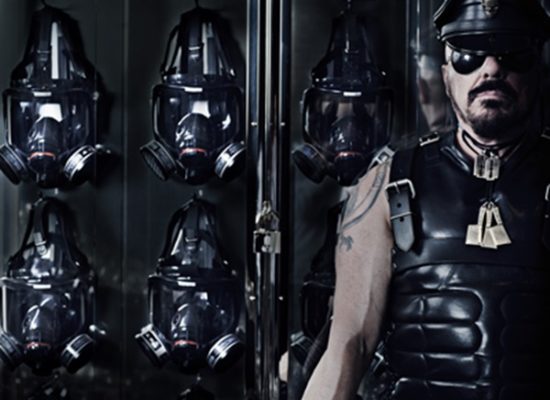Peter Marino started collecting almost by accident. He had been working for Andy Warhol at the Factory. “He paid me in art,” said Marino, standing with his back to the window of a conference room in his 36th floor Midtown office.
Marino was decked out in the haute leather daddy attire he is known for, his fingers heavy with silver skull rings, a skull at the center of his biker cap, and a cluster of flat silver ornaments hanging from a necklace over his black leather bodice, which punctuated his speech with the sound of gentle clinking.
“That sounds very chic, but it wasn’t…. I had no money.” Warhol gave Marino a check to open his first studio. “[Warhol] said, ‘If you’re smart you won’t cash this because someday my signature will be worth more than the check.’ And he was right. But I needed to pay the rent.”
Given the origin of Marino’s collecting, it’s no surprise that a work by Warhol, a red painting called Human Heart (ca. 1979), has pride of place in Marino’s new show “One Way: Peter Marino,” which is due to open at Miami’s Bass Museum of Art on December 4.
“I’m a Leo. I rule the heart. So was Andy,” said Marino about the painting. “He gave that to me for having worked for him.”
Curated by Palais de Tokyo cofounder Jérôme Sans, the exhibition gathers a mélange of work that shows off Marino’s collection while also demonstrating his contribution to fashion, architecture, and art. And judging from the preview we attended, it will look a lot like Marino the man: One gallery will have sleek leather-clad walls, there will be a commissioned work made with knives, and there will be skulls seemingly everywhere.
Marino is the go-to architect for the toniest high-end fashion boutiques. Chanel, Louis Vuitton, and Ermenegildo Zegna are a few of his clients. But he is also beloved for his penchant for integrating into his designs site-specific commissioned artwork. For Louis Vuitton Island Maison, a flagship store in Singapore, the architect capped his glass-and-steel pavilion with a gargantuan Richard Deacon sculpture suspended from the ceiling. Jean-Michel Othoniel has created several works for Chanel boutiques the world over including one 60-foot-tall “pearl necklace” for a recently designed boutique. The exhibition, likewise, will be multifaceted.
Rooms will be organized by theme, in homage to Marino’s cross-disciplinary practice. One gallery will be devoted to architectural projects that were never completed, his “unborn children,” as he calls them. There will be a Pop art gallery; a “Treasury Room” containing bronze boxes that Marino created; a “Deutsche Gallery” housing works by German artists, including paintings by Anselm Kiefer and sculpture by Georg Baselitz; and a room showing only portraits of Marino by such artists as Damien Hirst (a glass cabinet filled with black gas masks) and Francesco Clemente.
The exhibition culminates with the recreation of 18th-century German composer Christoph Willibald Gluck’s opera Orfeo ed Euridice—a collaboration with, among others, Francesco Clemente and Raf Simons (the opera was originally staged in the architect’s home). From there, visitors will enter a six-foot-by-six-foot red lacquered space with a pure white work by Robert Ryman to offer, per Marino, “a little bit of spiritual cleansing.”
Each room will contain work that Marino created, work he collected, and work he commissioned.
Though Marino’s collection of Renaissance and baroque bronzes was shown at the Wallace Collection in London in 2010, the Miami show will be Marino’s first museum show in the US and the first show of its kind, for Marino, anywhere.
The work displayed around Marino’s office would be well-suited to dramatic lighting. By the elevator, there are several high-polish stainless steel sculptures by Joel Morrison, including one of an animalistic jaw with bullets for teeth; there’s the aforementioned Hirst portrait with gas masks, as well as a spot painting with black spots (the only one, we were told, that the artist has done with only black spots); several large paintings by Richard Prince, and a large silver trunk that Marino designed. Much of the work will make its way down to the show. Perhaps unsurprisingly, of the 47 artists currently listed in the show, only one, Paola Pivi, is a woman.
The show will also house five site-specific installations by Gregor Hildebrandt, Guy Limone, Farhad Moshiri, Jean-Michel Othoniel, and Erwin Wurm, the last of which is a portrait of Marino.
“I was a little bit nervous,” said Marino of Wurm’s commission, “because if you’ve seen the portraits that Erwin Wurm does of people, he usually makes men 11-feet-tall, very pregnant, with exaggerated noses.” The artist, whose inclusion in the show was at Sans’s suggestion, had asked Marino for his cap and coat, which renewed the architect’s fear, who wondered if Wurm was going to conduct some kind of voodoo ritual. “What do you mean my hat and coat—are you going to do something to me?” Marino said. Then he complied and gave over his favorite motorcycle jacket. The final piece you’ll see when exiting the show is a skeleton in nothing but Marino’s hat and jacket, Peter Marino in One Hundred Years.
